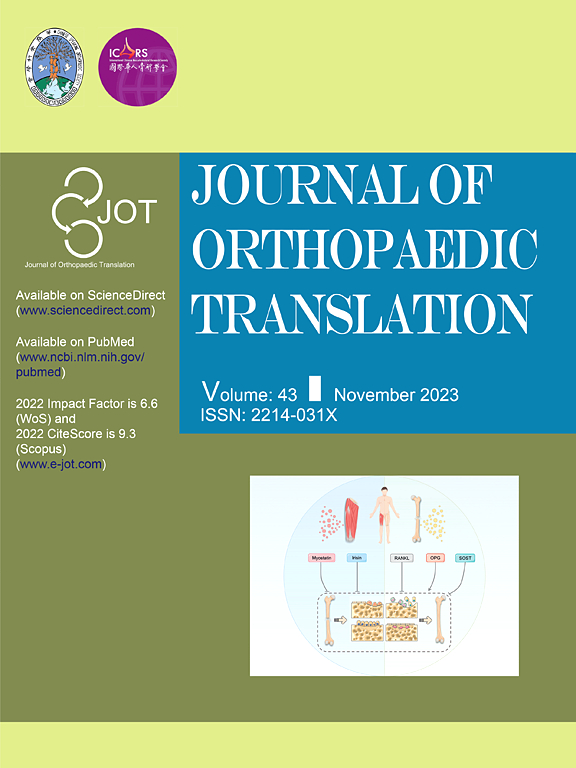Integration of longitudinal load-bearing tissue MRI radiomics and neural network to predict knee osteoarthritis incidence
IF 5.9
1区 医学
Q1 ORTHOPEDICS
引用次数: 0
Abstract
Background
Load-bearing structural degradation is crucial in knee osteoarthritis (KOA) progression, yet limited prediction models use load-bearing tissue radiomics for radiographic (structural) KOA incident.
Purpose
We aim to develop and test a Load-Bearing Tissue plus Clinical variable Radiomic Model (LBTC-RM) to predict radiographic KOA incidents.
Study design
Risk prediction study.
Methods
The 700 knees without radiographic KOA at baseline were included from Osteoarthritis Initiative cohort. We selected 2164 knee MRIs during 4-year follow-up. LBTC-RM, which integrated MRI features of meniscus, femur, tibia, femorotibial cartilage, and clinical variables, was developed in total development cohort (n = 1082, 542 cases vs. 540 controls) using neural network algorithm. Final predictive model was tested in total test cohort (n = 1082, 534 cases vs. 548 controls), which integrated data from five visits: baseline (n = 353, 191 cases vs. 162 controls), 3 years prior KOA (n = 46, 19 cases vs. 27 controls), 2 years prior KOA (n = 143, 77 cases vs. 66 controls), 1 year prior KOA (n = 220, 105 cases vs. 115 controls), and at KOA incident (n = 320, 156 cases vs. 164 controls).
Results
In total test cohort, LBTC-RM predicted KOA incident with AUC (95 % CI) of 0.85 (0.82–0.87); with LBTC-RM aid, performance of resident physicians for KOA prediction were improved, with specificity, sensitivity, and accuracy increasing from 50 %, 60 %, and 55 %–72 %, 73 %, and 72 %, respectively. The LBTC-RM output indicated an increased KOA risk (OR: 20.6, 95 % CI: 13.8–30.6, p < .001). Radiomic scores of load-bearing tissue raised KOA risk (ORs: 1.02–1.9) from 4-year prior KOA whereas 3-dimensional feature score of medial meniscus decreased the OR (0.99) of KOA incident at KOA confirmed. The 2-dimensional feature score of medial meniscus increased the ORs (1.1–1.2) of KOA symptom score from 2-year prior KOA.
Conclusions
We provided radiomic features of load-bearing tissue to improved KOA risk level assessment and incident prediction. The model has potential clinical applicability in predicting KOA incidents early, enabling physicians to identify high-risk patients before significant radiographic evidence appears. This can facilitate timely interventions and personalized management strategies, improving patient outcomes.
The Translational Potential of this Article
This study presents a novel approach integrating longitudinal MRI-based radiomics and clinical variables to predict knee osteoarthritis (KOA) incidence using machine learning. By leveraging deep learning for auto-segmentation and machine learning for predictive modeling, this research provides a more interpretable and clinically applicable method for early KOA detection. The introduction of a Radiomics Score System enhances the potential for radiomics as a virtual image-based biopsy tool, facilitating non-invasive, personalized risk assessment for KOA patients. The findings support the translation of advanced imaging and AI-driven predictive models into clinical practice, aiding early diagnosis, personalized treatment planning, and risk stratification for KOA progression. This model has the potential to be integrated into routine musculoskeletal imaging workflows, optimizing early intervention strategies and resource allocation for high-risk populations. Future validation across diverse cohorts will further enhance its clinical utility and generalizability.

纵向承重组织MRI放射组学与神经网络的结合预测膝关节骨关节炎的发病率
承重结构退化在膝关节骨关节炎(KOA)的进展中至关重要,然而有限的预测模型使用承重组织放射组学来影像学(结构性)KOA事件。目的:我们旨在开发和测试一种负荷组织加临床变量放射学模型(LBTC-RM)来预测放射学KOA事件。研究设计风险预测研究。方法从骨性关节炎倡议队列中选取基线时无影像学KOA的膝关节700例。我们在4年的随访中选择了2164例膝关节mri。LBTC-RM综合了半月板、股骨、胫骨、股胫软骨的MRI特征和临床变量,采用神经网络算法在总发展队列(n = 1082例,542例与540例对照)中开发。最终的预测模型在整个试验队列中进行了测试(n = 1082, 534例对照,548例对照),其中整合了5次访问的数据:基线(n = 353, 191例对照,162例对照),3年前KOA (n = 46, 19例对照,27例对照),2年前KOA (n = 143, 77例对照,66例对照),1年前KOA (n = 220, 105例对照,115例对照),KOA事件(n = 320, 156例对照,164例对照)。结果在整个测试队列中,LBTC-RM预测KOA事件的AUC (95% CI)为0.85 (0.82 ~ 0.87);在LBTC-RM辅助下,住院医师预测KOA的能力得到了提高,特异性、敏感性和准确性分别从50%、60%和55%提高到72%、73%和72%。LBTC-RM输出显示KOA风险增加(OR: 20.6, 95% CI: 13.8-30.6, p <;措施)。与4年前的KOA相比,负重组织的放射组学评分增加了KOA的风险(OR: 1.02-1.9),而内侧半月板的三维特征评分降低了KOA发生的OR(0.99)。内侧半月板二维特征评分较2年前KOA症状评分的or值(1.1-1.2)增加。结论我们提供了承载组织的放射学特征,以改进KOA风险水平评估和事件预测。该模型在早期预测KOA事件方面具有潜在的临床适用性,使医生能够在重要的影像学证据出现之前识别出高危患者。这可以促进及时干预和个性化管理策略,改善患者预后。本研究提出了一种结合基于纵向mri的放射组学和临床变量的新方法,利用机器学习预测膝关节骨关节炎(KOA)的发病率。通过利用深度学习进行自动分割和机器学习进行预测建模,本研究为KOA的早期检测提供了一种更具可解释性和临床适用性的方法。放射组学评分系统的引入增强了放射组学作为基于虚拟图像的活检工具的潜力,促进了KOA患者的非侵入性、个性化风险评估。研究结果支持将先进的成像和人工智能驱动的预测模型转化为临床实践,有助于KOA进展的早期诊断、个性化治疗计划和风险分层。该模型具有整合到常规肌肉骨骼成像工作流程的潜力,可优化高危人群的早期干预策略和资源分配。未来在不同人群中的验证将进一步增强其临床应用和推广。
本文章由计算机程序翻译,如有差异,请以英文原文为准。
求助全文
约1分钟内获得全文
求助全文
来源期刊

Journal of Orthopaedic Translation
Medicine-Orthopedics and Sports Medicine
CiteScore
11.80
自引率
13.60%
发文量
91
审稿时长
29 days
期刊介绍:
The Journal of Orthopaedic Translation (JOT) is the official peer-reviewed, open access journal of the Chinese Speaking Orthopaedic Society (CSOS) and the International Chinese Musculoskeletal Research Society (ICMRS). It is published quarterly, in January, April, July and October, by Elsevier.
 求助内容:
求助内容: 应助结果提醒方式:
应助结果提醒方式:


